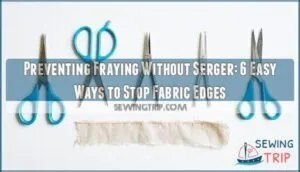This site is supported by our readers. We may earn a commission, at no cost to you, if you purchase through links.
 Yes, viscose does shrink – sometimes dramatically.
Yes, viscose does shrink – sometimes dramatically.
You’re dealing with regenerated cellulose fibers that contract when exposed to heat, moisture, or aggressive washing.
Hot water and dryer heat cause the most damage, with garments potentially shrinking 10-20% or more.
Cold water washing helps, but won’t eliminate the risk entirely.
The fibers are inherently unstable from manufacturing, making them prone to return to their original compact form when given the opportunity.
Even gentle handling can’t guarantee zero shrinkage.
Your best defense involves understanding viscose’s temperamental nature and adjusting your care routine accordingly, though some shrinkage secrets might surprise you.
Table Of Contents
- Key Takeaways
- Why is Viscose Prone to Shrinking?
- Understanding The Shrinkage Potential of Viscose
- Factors That Contribute to Viscose Shrinkage
- Does Viscose Shrink in The Dryer?
- Does Viscose Shrink When Washed?
- Can Viscose Shrink With Every Wash?
- Does Viscose Shrink in Cold Water?
- Does Viscose Shrink in Hot Water?
- Can Viscose Shrink When Dry Cleaned?
- How to Prevent Viscose From Shrinking
- Frequently Asked Questions (FAQs)
- Conclusion
Key Takeaways
- You’ll face 3-5% shrinkage with your viscose garments during the first wash, especially if you use hot water or high heat – this isn’t reversible once it happens.
- Cold water washing is your best defense against shrinkage, keeping temperatures below 86°F to prevent the fiber from swelling and contraction that causes permanent size changes.
- Skip the dryer entirely since heat causes up to 25% shrinkage in a single cycle – air drying flat is the only safe way to maintain your garment’s original dimensions.
- You can’t completely eliminate shrinkage risk even with perfect care, as viscose’s regenerated cellulose structure makes it inherently unstable and prone to gradual size reduction over time.
Why is Viscose Prone to Shrinking?
When you’re dealing with viscose fabric shrinkage, you’re working with a material that’s basically caught between two worlds.
This semi-synthetic fabric combines wood pulp cellulose with chemical processing, creating viscose fiber that mimics silk’s drape but lacks cotton’s durability.
The viscose properties that make it appealing – its lightweight feel and breathability – also make it vulnerable.
Unlike natural fibers, viscose fiber shrinkage occurs because the regenerated cellulose structure weakens dramatically when wet.
Hot water, aggressive washing, and heat exposure cause the fibers to contract and lose their original shape.
The viscose shrinkage rate can be significant if you don’t follow proper fabric care guidelines.
Preventing viscose shrink requires understanding that delicate handling isn’t optional – it’s essential for maintaining your garment’s fit and appearance.
Understanding viscose wrinkle issues is also vital in caring for viscose fabrics to prevent further damage.
Understanding The Shrinkage Potential of Viscose
When you’re dealing with viscose care, understanding the actual shrinkage potential helps you make informed decisions about your fabric choices.
Laboratory shrinkage tests reveal that viscose can shrink between 2% to 8% after the first wash, depending on how you handle it. The cellulose structure that gives viscose its fabric softness also makes it vulnerable – these fibers swell and contract when they meet water, causing those unwanted dimensional changes.
Here’s what affects your viscose shrinkage rate:
- Fabric construction matters – woven viscose shrinks more than viscose blends or knits
- Treatment makes a difference – untreated fabrics show higher shrinkage than those with anti-shrink finishes
- Fiber strength plays a role – pure viscose is more prone to shrinking than blended versions.
Understanding viscose wrinkle factors can also help in managing the overall appearance of the fabric.
Industry guidelines consistently show that preventing viscose shrink starts with understanding these baseline shrinkage rates. When you know that your viscose clothing shrink potential sits in that 2-8% range, you can plan accordingly and choose appropriate care methods.
Factors That Contribute to Viscose Shrinkage
Several key factors determine whether your viscose garments will shrink during care and handling. Understanding these viscose shrinkage factors helps you maintain your favorite pieces longer.
Fiber Strength weakens when viscose gets wet, making it vulnerable to dimensional changes. The loose molecular structure allows water to disrupt bonds between fibers, leading to permanent deformation.
Key factors that cause fabric shrinkage:
- Moisture Absorption – Viscose fibers swell when wet, losing up to 50% of their strength and becoming prone to distortion
- High temperatures – Heat above 40°C can cause 8-10% shrinkage in a single wash cycle
- Aggressive washing methods – Machine agitation increases fiber entanglement and shrinkage rates
- Improper fabric handling – Wringing or twisting wet viscose permanently damages the structure
- Poor drying techniques – Tumble drying at high heat can shrink garments by up to 25%
Preventing viscose shrink requires gentle care throughout the cleaning process. Reducing viscose shrinkage becomes manageable when you understand that this delicate fabric needs cold water, minimal agitation, and careful drying to maintain its original dimensions. To minimize wrinkles and shrinkage, consider using viscose care tips that focus on handling and storage techniques.
Does Viscose Shrink in The Dryer?
Yes, viscose shrinks dramatically in the dryer. The heat causes your viscose fibers to lose structural integrity and contract permanently. You’ll see up to 25% shrinkage after just one high-heat cycle – that’s like your medium shirt becoming a small!
Even low-heat settings won’t save you from moderate shrinkage. The mechanical tumbling combined with any heat creates the perfect storm for fabric relaxation and dimensional changes.
Here’s what happens with different dryer settings:
| Dryer Setting | Shrinkage Rate | Fabric Condition |
|---|---|---|
| High Heat | Up to 25% | Severe distortion |
| Low Heat | 10-15% | Moderate shrinkage |
| Air Dry | 5-8% | Minimal changes |
Understanding viscose care tips is essential to prevent damage. Your best bet? Skip the dryer entirely. Air drying keeps your viscose looking and fitting like new. Those care labels warning "Do Not Tumble Dry" aren’t just suggestions – they’re your shrinkage control lifeline. Remember, once viscose shrinks in the dryer, there’s no going back to its original size.
Does Viscose Shrink When Washed?
Viscose shrinks when washed due to its delicate fiber structure and high water absorption.
The majority of shrinkage occurs during the first wash as fibers relax and contract. Machine washing increases shrinkage rates compared to hand washing, especially with hot water and aggressive agitation.
Cold water washing methods help maintain fabric softness and reduce dimensional changes. Viscose blends may shrink differently depending on fiber composition.
Following proper viscose care instructions prevents excessive shrinkage and preserves garment fit. To minimize shrinkage, it’s vital to follow the recommended viscose care tips for washing and drying, using techniques that maintain the fabric softness and prevent excessive shrinkage, while considering the importance of proper care and viscose blends.
Can Viscose Shrink With Every Wash?
Unfortunately, the answer is yes – viscose can shrink with every wash. This delicate fabric gradually loses its original size through repeated laundering cycles, making each trip to the washing machine a potential threat to your garment’s fit.
Here’s what you need to know about managing viscose shrinkage control:
- Progressive shrinkage occurs – Studies show up to 3-5% additional shrinkage after repeated washes, even with proper care
- Machine washing increases risk – Regular cycles cause more cumulative shrinkage than gentle hand washing methods
- Viscose blending helps – Fabrics mixed with polyester or spandex resist shrinkage better than pure viscose
- Heat accelerates damage – Each exposure to warm water or tumble drying compounds the shrinking effect
- Gentle washing extends life – Cold water, mild detergents, and air drying minimize ongoing size reduction
Following viscose care instructions religiously won’t eliminate shrinkage entirely, but it’ll substantially reduce the rate. Remember, fabric softening treatments and proper viscose care tips help maintain your garment’s original dimensions longer. Understanding viscose fabric properties is vital to preventing unnecessary damage and extending the life of your clothing.
Does Viscose Shrink in Cold Water?
Good news: cold water won’t cause viscose shrinkage control problems. Your viscose fabric shrink concerns vanish when you choose temperatures below 86°F (30°C). Cold water viscose care protects the delicate fibers from the thermal stress that triggers shrinkage.
When you ask "does viscose shrink" in cold conditions, the answer is reassuring. Cold water maintains the fiber structure, preventing the swelling and contraction that causes viscose shrink in water scenarios. This gentle fabric treatment preserves your garment’s original dimensions.
However, viscose handling requires attention to other factors. Even in cold water, excessive agitation can damage the weakened wet fibers. Hand washing remains your safest bet for viscose shrinkage control. Machine washing works too, but use delicate cycles with minimal spin speeds.
Understanding fabric shrinkage types is vital for maintaining the quality of your garments. Think of cold water as your fabric’s best friend – it cleans effectively without the destructive heat that makes viscose fabric shrink permanently.
Does Viscose Shrink in Hot Water?
Hot water transforms viscose from a durable fabric into a shrinking nightmare.
Hot water turns your beloved viscose into a shrunken disaster within minutes.
Laboratory studies reveal that temperatures above 104°F can cause up to 10% size reduction—twice the shrinkage rate of cold water washing.
The cellulose fibers swell dramatically when exposed to heat, then contract aggressively during drying.
Here’s what happens when hot water meets viscose:
- Fiber structure weakens by 50% when wet and heated
- Garment dimensions shrink 8% in length, 6% in width
- Fabric loses its original drape and softness
- Permanent distortion occurs within one wash cycle
- Recovery becomes nearly impossible after heat damage
Water temperature directly controls shrinkage severity.
While cold water keeps viscose stable, hot water accelerates fiber breakdown.
This isn’t gradual wear—it’s immediate transformation.
Your favorite viscose blouse can become unwearable after one hot wash.
For ideal viscose care and shrinkage control, stick to temperatures below 86°F.
This simple change preserves fabric softness and maintains viscose durability throughout countless washes.
Understanding fabric shrinkage rates is vital to preventing damage to your garments, and it helps in maintaining the original drape and ensuring the fabric remains soft and durable.
Can Viscose Shrink When Dry Cleaned?
While hot water poses obvious risks, dry cleaning presents a different challenge for viscose garments. You might think professional cleaning eliminates shrinkage concerns, but that’s not entirely accurate.
Dry cleaning uses chemical solvents instead of water, which reduces moisture-related shrinkage risks substantially. However, Dry Cleaning Risks still exist. The heat and pressing involved can affect Viscose Fabric Care outcomes.
Chemical solvents may react differently with various viscose blends, potentially causing unexpected size changes. The following table summarizes the risks associated with different cleaning methods:
| Cleaning Method | Shrinkage Risk | Fabric Impact |
|---|---|---|
| Traditional Washing | High | Fiber swelling/contraction |
| Dry Cleaning | Low-Medium | Chemical reaction potential |
| Professional Care | Variable | Depends on technique |
Delicate Handling remains essential even with professional services. Chemical Effects vary based on garment construction and fiber blends. For Shrinkage Prevention, communicate your concerns to the dry cleaner.
They can adjust their process accordingly, ensuring your viscose garment care meets expectations while minimizing fabric shrinkage tips disasters. Understanding viscose drying methods is essential to maintain the quality and texture of the fabric.
How to Prevent Viscose From Shrinking
Five prevention strategies protect your viscose garments from unwanted shrinkage. Hand washing with cold water and mild detergent preserves fiber integrity better than machine washing.
These gentle washing techniques prevent the fiber damage that causes fabric shrinkage prevention issues. To maintain the quality of your viscose garments, for the best results, follow proper viscose care tips to extend their lifespan.
- Cold Water Washing: Use water below 20°C with mild detergent to maintain fabric structure
- Air Drying Methods: Lay flat on towels instead of hanging to prevent stretching
- Low-Heat Ironing Techniques: Iron inside-out while damp using fabric softening steam
- Proper Storage: Keep in cool, dry places with 45-55% humidity levels
- Gentle Handling: Avoid wringing or twisting wet viscose to prevent fiber damage
Frequently Asked Questions (FAQs)
Does viscose shrink after every wash?
No, viscose doesn’t shrink after every wash if you’re careful. It’ll only shrink when exposed to hot water, heat, or aggressive agitation, so proper cold-water washing prevents repeated shrinkage.
How much will viscose shrink?
Like a cotton sweater meeting boiling water, viscose fabric typically shrinks 3-5% in length and width when exposed to hot water or high heat.
You’ll see the most dramatic shrinkage during the first wash, especially with lower-quality viscose that lacks pre-shrinking treatments during manufacturing, which can lead to significant changes in the fabric’s dimensions due to high heat.
Can I put viscose in the dryer?
You can’t put viscose in the dryer safely.
Heat causes the fibers to shrink and weaken, potentially ruining your garment.
Air dry flat instead to maintain the fabric’s shape and size.
Should you size up or down in viscose?
Smart shoppers should size up when buying viscose garments. This fabric’s notorious shrinkage tendency means you’ll want extra room for inevitable contraction during washing and drying cycles.
Can you unshrink viscose clothing at home?
You can partially unshrink viscose by soaking it in lukewarm water with fabric softener for 30 minutes, then gently stretching while damp and air-drying flat.
How much does viscose typically shrink percentage-wise?
An ounce of prevention is worth a pound of cure" – viscose typically shrinks 3-5% when exposed to hot water or high heat.
But you can minimize this by washing in cold water and air-drying flat.
Does viscose shrink more than cotton fabrics?
Yes, viscose typically shrinks more than cotton. Viscose fibers weaken when wet and lose structural integrity, making them more susceptible to shrinkage from heat and agitation than cotton’s stronger fibers.
Will viscose shrink if steamed or ironed?
Steaming and ironing viscose can cause shrinkage if you’re not careful.
Heat relaxes the fibers, making them contract and shrink.
Use low heat settings and keep the fabric damp while ironing to minimize shrinkage risk.
Does viscose shrinkage depend on fabric quality?
Higher-quality viscose fabrics typically shrink less than cheaper versions because they’re pre-treated with stabilizers during manufacturing.
You’ll find low-quality viscose shrinks more dramatically due to weaker fibers and less processing control, which can be considered a key factor in the difference.
Conclusion
Like a ticking time bomb in your closet, viscose shrinkage remains an ever-present threat to your favorite garments.
Understanding does viscose shrink helps you navigate this fabric’s temperamental nature with confidence.
You’ve learned that proper care techniques—cold water washing, gentle handling, and air drying—significantly reduce shrinkage risk.
While you can’t eliminate the possibility entirely, these prevention strategies protect your investment and extend garment life effectively.













